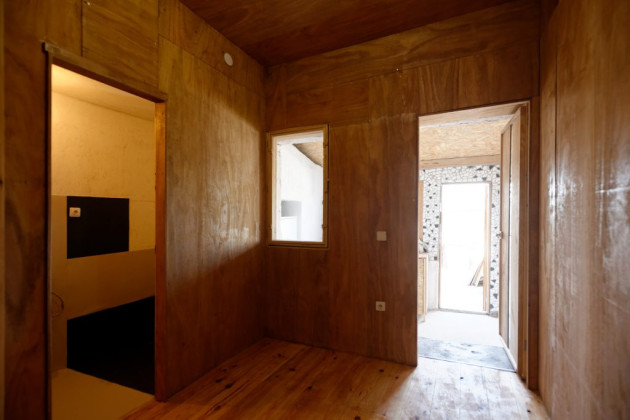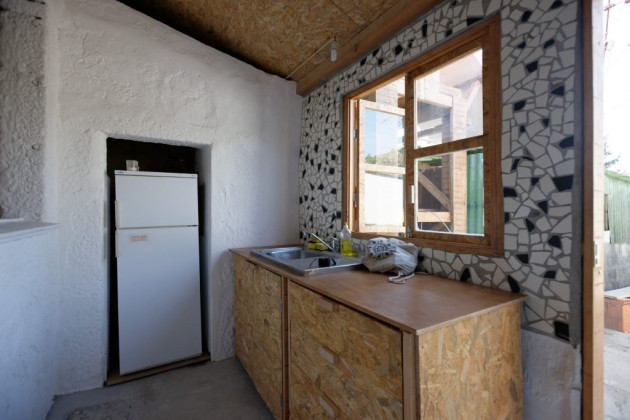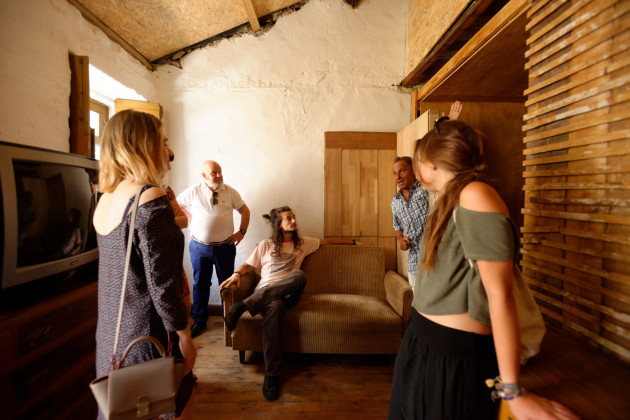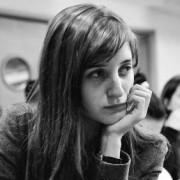Educational Possibilities in Urban Refurbishment
Critical Concrete, concentrating on the refurbishment of socially relevant spaces of Porto suburbs, shows us how to be super cool by being super normal
Sebnem Soher: What is Critical Concrete? I know about the Summer School, but I guess there’s more to it than that. Could you please tell to us a little bit more about the organization, about your practice and your goals?
Samuel Kalika: Yes. Critical Concrete is basically an association that organizes its activities around the refurbishment of socially relevant spaces in educational formats.
SS: So, education is a central aspect of the organization.
SK: Yes. The summer school is one of the educational formats, and there’s also short-term workshops, gatherings—these sorts of things. Right now, our activities are divided in 3 main directions, and one of them is the summer school. In the school project, we, with the municipality, select a house—in this case in Ramalde, Porto—which corresponds to our capacity, as well as the need of refurbishment.
There are also two more, lesser known directions that are currently in process. One of them is a research lab, working in collaboration with another organization. Right now, the research is focused on sustainable heating strategies for the south of Europe; since we have noticed that, excluding the mild climate areas, people in southern Europe suffer from ridiculously cold temperatures inside their own houses. People actually suffer from the cold, in the south. We try to tackle this issue with strategies that are realistic in terms of humble people. We work on very low-cost solutions that are based on recycled materials. These should be low-tech solutions, and therefore easily reproducible by people. We started this research lab only a few months ago, and built our first prototype—a rocket stove. The rocket stove works with wood, and uses it to combust and create substantial heat; working with basic scrap wood or pallets. In our case it makes a lot of sense; because we can get a lot of scrap wood very easily, with this rocket stove, we can heat our spaces in winter. We are now also investigating the potentials of compost heating. We are doing the research and the math to create the first prototype.
The third part of our activity is our project space, which is locally embedded in our neighbourhood. It is an in-between space right now. Our production space is here. At the same time, we work on public programs with the community, like organizing neighbourhood markets, workshops, cinema sessions… We play with the format, but mostly the events are locally initiated. For example, next month we will start hosting yoga classes. That’s pretty much all of it.
SS: In that case, let me ask you about those collaborations. How do you select your partners, mentors and initiators? How do you reach the people who get involved with the project?
SK: Our partners for the local events are normally people from the neighbourhood, as well as friends and colleagues. Mostly they are the people that we get to know during the process of the projects; sometimes when we think that there is something to share, we invite them. Sometimes they come to us with an idea for using the space, and we make a deal. So far it’s been us for the cinema sessions. But now we are inviting people to curate these sessions. The last one was curated by João Paulo, an illustrator, and a friend of ours. He curated a cinema session that focused in animation. For the summer school, it’s a little different. There really are many partners for that. There are supporting partners that we work with all year long to address issues, and partners to contact and try to get material from, or discounts, or sometimes funding. Then there are mentors, whom we have chosen based on their conceptual approach, and its relation to our concept of sustainability. Everybody is using the term sustainability, but it has a very specific meaning for us.
SS: How do you fund everything?
SK: The project is mostly self-financed. What we finance the project with, which is paying for material and paying the mentors, comes mainly from the inscription fee of the students. We also get small donations from institutions, such as the Millennium Bank and Bosch, for example. Sometimes it’s not money, but they help us acquire tools, which provides a lot of support for us. In the first year, we were also part of the Actors of Urban Change Program, funded by Robert Bosch, and coordinated by MitOst. So we collect money and material support from a lot of sources, and you can see on our website how we spend that money. It’s very transparent.
SS: What is your relation to the local authorities and institutions that support your project? Does the financial support affect the content of your work?
SK: No, people who support us and provide us the money don't pressure us in any way to affect the content of the project. Some want a bit of visibility of course, and some do not. They are all happy to get news and updates from the field of action. This is a social responsibility project for them, and it’s a very good agreement for both sides; because otherwise, we would have to raise the price of the summer school, which is already not affordable for everyone. If we criticize our project for having sponsors, then we would have to criticize it for not being accessible too. I wish we could get more funding, so that we can lower the participation fee.
SS: May I ask about another aspect of accessibility, or availability, since you already mentioned it? Do you see what you do as providing public service? Is it available to the local community? Or do you get requests from the local authorities, NGO’s and other small initiatives or even individual people?
SK: We do, sometimes. There are several types of requests, but first, I will go a little bit sideways on your question. First of all, it’s important to mention that we are not a public service; we are a private entity, and we try to fit ourselves in the void left by some of the public services. We work with the reality of things. For example, in almost every country it might be different but nonetheless, it’s always very hard to finance the refurbishment of private property with public resources. There are very poor “private” people, who cannot get public support. This is one of the situations in our areas of action. Sometimes we work with the local authorities and municipalities to detect those cases. District municipalities are the ones who really have this crucial information and they can direct you to the right social services in the right neighbourhood, to the people who need this mediation.
We also get collaboration invitations, but there’s always a problem of funding. We are a very young initiative, we are doing a lot, and meanwhile surviving. It’s good that we are becoming known and that our work is being appreciated. But we’re not in a place to completely finance our work.
SS: When I visited you in the Actors of Urban Change meeting back in February, in Porto, it was interesting for me to find out about the support the Lisbon municipality was offering to community projects. Do you also have a similar program in Porto?
SK: I haven’t been diving into the possibilities, or the offerings related to the participatory budget of Porto. But as far as I was informed, you cannot apply as an organization. You have to apply as an individual, you have to do a lot of work for it, and there’s no guarantee at all that you are going to get the work. It’s like a big contest for ideas. We are trying to get more direct and more structured funding, for a concrete project.
SS: Let me jump to the concept of interdisciplinarity. Is Critical Concrete a group of urban professionals only? I know that you are not an architect. What do you think of working with people from different disciplines on spatial projects?
SK: I think public questions should be answered with regards to the interests of everyone. Some topics are not so complicated, but some are really, really complicated. It might be hard to understand global economy when you don’t have a background in economy. You cannot refurbish a house if you are not an architect or a builder. But you can communicate. Sometimes it’s even more complicated to create bridges between things. When architects talk about participatory projects, there’s a big chance that they’re not talking about participation. Last year, when we were working on Alfredo’s house in the summer school, we wanted to include him in the design process. But we had some resistance from within our team. Also when we talked to him we realized that he is not an expert in many parts of the project. There are architects, constructors, engineers who have the technical expertise. We were not clear enough about what was happening. When you want to make a participatory process work, you also need to adapt your language to put everyone on the same level. All the different sectors have their own vocabulary, and even assign different meanings to the same words. It’s quite understandable and natural. But to make things work, it should actually become even more natural.
Architects of our time are fantastic artists. They can sculpt amazing forms; and sometimes, there is very beautiful engineering going on—but as soon as they get out of scale, they forget they are doing it for the people.
SS: Recently, socially relevant architecture is a very hot topic though.
SK: Economic crisis had terrible consequences for most people, but in a conceptual level, it had some positive effects too. It did push architects into rethinking their practice. This has led to a practice that is more bottom-up than one that is top-down.
SS: May I ask something about you, and not about Critical Concrete? I read that you have been working in Berlin’s ZK/U (Center for Art and Urbanistics) before this project came on. How did that experience help you in initiating this project?
SK: My story with ZK/U started with an internship. I wanted to get involved in a production center, which was like our project space. A workshop with woodworking and different types of production was already rooted in my mind, even back then. After I applied, I first talked to Philip Horst, one of the three founders of the center, along with Matthias Einhoff and Harry Sachs. They told me I was welcomed to participate in the process of developing a residency for artists. When my internship ended, the residency project was starting, but they didn’t have a project coordinator on site. So I stayed with them, and it turned into a great experience for me—seeing a space built from scratch, applying for EU funding, running a team... I basically learned all about the job there; and then it was time to start my own project. And also; it was really cold in Berlin.
SS: How did you come to select Porto for your project?
SK: I had a lot of criteria to choose upon. Climate was one of them. But really, I wanted to work in the south of Europe, and I had been in Spain before I came to Germany. So we concentrated in Portugal and Greece as two alternatives. I also didn’t want to start the project in a capital city, I wanted it to be in a secondary city. I have been in capitals for many years and I got tired of the hype around them. Even in Porto, which is not a capital but still a very big city of Portugal, we looked for a secondary neighbourhood, not a central one. I visited Porto in March 2015 for the first time. Afterwards I put together all my holidays in ZK/U, and came here, which was when I met Juliana Trentin, who is now the current coordinator of the organization. And we started to work together. We looked for a place and we started a website…
SS: Portuguese cities are under a big pressure of touristification, there are a lot of debates on gentrification and the commercialization of the city center. Especially Lisbon seems to be attracting a lot of capital. I keep reading news about rent control, Airbnb, etc. How are things recently in Porto; and how did that affect your decisions so far?
SK:This is one of the reasons why we are in the suburbs. I think it’s nice to be surrounded by young and beautiful people, but I also think that it’s interesting to work with “super cool” grandmas, and actually with “super normal” people, who are not just young, beautiful, mobile; but who are living the beautiful life.
The city center is already quite gentrified and it’s very easy to be critical about it. We also have to understand that here in Porto, not everyone is completely unhappy about it like the architect-urbanist elite—who are very pissed off about tourism and gentrification. Before, even the main streets of the city center, which is completely refurbished now—they were completely run down, a lot of characteristic buildings were unoccupied and falling down; the city did not have much money. So it’s not all bad; tourism is bringing a lot of income for the citizens, too. Of course it shouldn’t be like that it was in Berlin—it has to be monitored and controlled. I am critical about automatic criticism. Of course it's a major issue that has to be dealt with—we don't want locals to be kicked out by massive touristification—but it's not the evil.
SS: What do you think is different about Berlin’s history of gentrification?
SK: Berlin has its unique past, beginning from the WWII. A substantial part of the city was destroyed and the city had shrunk. With the reunification, the city shrunk again. In the 80s, a certain group of people moved to the west for ideological reasons—as well as for really good reasons like avoiding military service. Very dynamic, progressive people with open mentalities moved to the west. After the reunification, with a lot of the buildings became vacant, and the city became more affordable. This is for sure an attractive place to move in and be creative at, and to do creative projects. This is why Berlin has been the origin of good music and art, with lots of initiatives and cool people. With the changing financial situation in Germany, Berlin of course attracted a lot of investors. Everything happened very quickly, and speculatively.
SS: Can we say that you, and organisations like yours, are the cool kids of today?
SK: (Laughs) In a way, I guess we try. Not to be the cool people but to provide cultural and social services through our project. We didn’t want to be the like foreigners who came to the neighbourhood and did fancy stuff. I was surprised and happy to see that the neighbours were excited about the project too. This place used to be a kindergarten, where 3 or 4 generations of people had been in when they were 6 years old. A lot of people have their memories, and they are happy to see this place accessible to others, open for new projects and events. We would like them to propose ideas too. We would be really glad to facilitate their ideas.
SS: This has been a very nice conversation, thank you so much. And I wish you good luck with the summer school. I think the student application process still has some more time left.
SK: Thanks for finding us and coming back to us. The deadline for applications is June 4th.
Related Content:
-

Refurbishment in Sants
-

NEST
-

Social Housing in Ibiza
-

A Refuge in Córdoba
-

Floating Home
-
No Easy Answers, But All The Right Questions
Sebnem Soher talked with Tiago Mota Saraiva, one of the members of architectural cooperative Ateliermob, about building collective know-how and networks that bring stakeholders together.
-

Setting the Tone
-
Seeds of Awareness
In the guidance of Michael Leung, this interview looks into a collective movement that flourishes at a street stall in Hong Kong as a reaction to the current development plans
 31.05.2017
31.05.2017

















